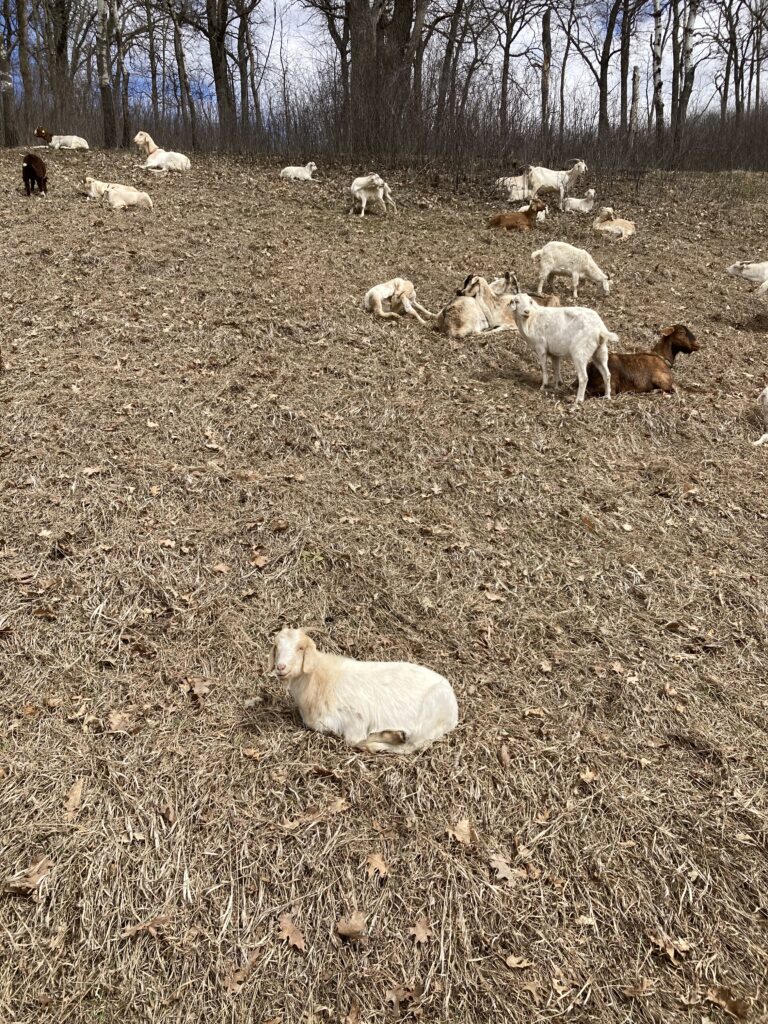So You Herd About Goat Prairies?

By Sommer Meyer, Central Field Specialist / AmeriCorps Member
Goat prairies go by many names: dry prairies, hill prairies, oak openings, juniper glades, dry lime prairie, and bluff prairie are all names given to the same type of plant community. Found mainly in the Driftless Area, a region in the Midwest comprising Southeast Minnesota, Northeast Iowa, Southwest Wisconsin, and Northwest Illinois, goat prairies can also be found throughout the plains region in southern and western Minnesota and into Iowa.
Goat prairies are usually located on steep, southwest facing slopes or bluff edges. In part due to the high amount of sunlight hitting the southwest slopes, the composition and drainage of the soil, and other geological features, goat prairies are characterized by shallow, dry, sandy, or even gravelly soil. Sandstone and limestone bedrock occur right beneath the soil in parts of the goat prairie, and will often be fully exposed at some points.
The vegetation in goat prairies is typically shorter and sparser than in other types of prairies. However, many of the native grass species found in other prairies are also found in goat prairies, including big bluestem, little bluestem, prairie junegrass, side-oats grama, hairy grama, and prairie drop-seed. Additionally, wildflowers such as pasque flower, silky aster, heath aster, prairie smoke, leadflower, purple prairie clover, and various goldenrod species are all found in goat prairies.
Multiple rare animal and plant species also make their homes in goat prairies, which often serve as critical habitats for these species. Included among the rare species living in goat prairies are the six-lined racerunner (a type of lizard) and several species of snakes: the prairie ring-necked snake, the North American racer, and the timber rattlesnake. Goat prairies also host several species of rare moths, leafhoppers, land snails, and butterflies, such as the “globally rare” ottoe skipper butterfly. Some of the more rare or important species of plants living in goat prairies include pale purple coneflower, ground plum, prairie turnip, silver bladder-pod, Carolina anemone, and Wilcox’s panic grass.
While goat prairies are a unique and vital habitat, they are also facing serious threats. Like many prairie ecosystems around the Midwest, goat prairies have evolved to be dependent on periodic fire. Because of the wildfire-suppression tactics used across the United States in the 20th century, many of the goat prairies in the Midwest have lost this critical component. Without the fires that would keep away trees, shrubs, and invading species, many goat prairies have been overtaken and transformed into deciduous forests. Additionally, prairies around the Midwest, including goat prairies, are threatened by land-use changes, such as being turned into agricultural land. The sections of native prairie that remain can end up being small and isolated, and not able to fully sustain itself without connection to the broader ecosystem.
Goat prairies may be under threat from encroaching brush, invasive species, and land-use changes, however the good news is that there are several things we can do to help goat prairies thrive! Prescribed burning of prairies is a vital land management tool becoming increasingly common around the United States to aid fire-dependent ecosystems. Additionally, manual removal of the trees, shrubs, and invasive species that threaten goat prairies can be incredibly helpful. All prairies, including goat prairies, are a vital part of Minnesota and Iowa’s natural landscape, and we must do what we can to protect them; in fact, the Conservation Corps itself has done many, many prairie restoration projects!

Sources:
www.nps.gov/articles/000/efmo_goatprairies.htm
www.dnr.state.mn.us/rys/pg/dryprairie.html
dnr.wi.gov/topic/landscapes/documents/elowch7/CTHER070WI.pdf